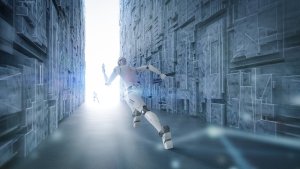The past-half century has spurred unprecedented economic growth for many developing countries – brought about by the rapid adoption of technological advancements – and has led to widely shared increases in prosperity, lifting billions out of poverty. But there is no guarantee that this process will continue in future decades.
Our new working paper on “Artificial Intelligence, Globalization, and Strategies for Economic Development,” challenges the long-standing assumption that technological progress will necessarily continue to advance broadly shared prosperity in developing countries. We argue that new developments in Artificial Intelligence (AI) may create the perfect storm to decouple technological advancement from broadly shared increases in living standards.
Dozens of developing countries have escaped from poverty in recent decades through a strategy of export-led growth, fueled by manufacturing goods produced with their abundant supply of cheap labor or their richness in natural resources. But AI poses a triple threat to this strategy. First, AI automates labor, which strips developing countries of their comparative advantage in cheap labor. Second, AI produces more output with fewer natural resources. And for nations that rely on exporting their natural resources to pay for food and other essentials, AI advancement could have deadly consequences. Third, AI operates in a “winner-takes-all” market.
Consider the example of a hypothetical village cobbler. In the past, a village’s best cobbler only mended a few more shoes than his less adept rival down the lane. In contrast, today’s best AI producers can easily achieve monopoly over their slightly worse competitors, because unlike a cobbler, an AI-producing firm has no physical restrictions on how many products it can create or how widely these products can be shared. This would be as if the best cobbler could produce limitless shoes — everyone would immediately switch to her product. These “winner-takes-all” markets privilege the most successful firms in AI-powered economies, a dynamic that could also widen income inequality between developed and developing nations.
As long as the winners and losers from technological progress are located within the same country, there is at least the possibility that domestic policy measures can be employed to compensate the losers. However, when technological progress disadvantages entire countries through global trade, domestic policy measures are insufficient to provide compensation to the losers of progress. This could leave entire nations worse off.
While proponents of neoliberalism have long-preached that technological progress benefits all, this dogma is not supported by theory nor by evidence. We cannot be sure that the wealth generated from technological advancement will “trickle down” to benefit developing countries, and especially the most vulnerable within developing countries. In fact, economic theory has always held that advances in technology create winners as well as losers.
And it’s worth remembering that for large parts of the post-Industrial Revolution era, advances in technology have not been associated with broadly shared prosperity: the early decades of that era saw declining standards of living. Read any Dickens novel for a portrait of the brutal realities laborers confronted. In fact, during the first decades of the Industrial Revolution, life expectancy actually decreased. And there is a wealth of evidence that there has not been shared prosperity within at least the US in recent decades. It was only in the 19th century that advanced countries broke from eons of subsistence living; and only from the middle of the 19th to the middle of the 20th century that inequalities were reduced. The half-century of growth that enabled the East Asian Miracle, when we zoom out, looks even more like a brief anomaly. There’s no reason to believe our comparatively brief success in advancing living standards for the average worker will continue forever, or that the convergence between the developed and the less developed will continue. Without appropriate public policy interventions, changes in technology can worsen inequalities within and between countries.
So how do we avoid that future technological progress reduces worker incomes and impoverishes the poorest among us further? We may be able to learn a lesson from history. The Industrial Revolution provides a case study in the labor challenges arising from technological transformation and suggests that collective action may be an antidote to some of our challenges.
Society initially struggled to navigate the Industrial Revolution’s rapid technological transition. But while it took time for workers to mitigate these challenges, eventually, widespread technological progress led to large increases in the marginal product of labor and harkened in an “Age of Labor.” Many of the Industrial Revolution’s innovations increased the productivity of workers, especially of the low-skilled segment. For example, mechanized cotton spinning increased the output of an individual worker by a factor of around 500 while reducing the skill requirements. Increased efficiency meant that market wages of workers rose. In economic language, technical progress during the Industrial Revolution was labor-using – it increased overall demand for labor and therefore raised wages. Additionally, labor organizing resulted in a new wave of protections for workers, including increased safety standards. Furthermore, the Industrial Revolution needed a productive workforce, which incentivized public schooling and in turn equalized education. However, the analogy to the Industrial Revolution may only go so far.
One of the defining challenges posed by the AI Revolution is that AI could be labor-saving overall, meaning that it could reduce demand for labor, and especially the types of unskilled labor that forms the basis of growth in many developing countries. This would simultaneously reduce workers’ pay and decimate their political power. AI might undermine the chance for workers in developing countries to ever acquire the same rights and protections that their counterparts in rich countries have been afforded through collective action during the “Age of Labor.”
Experts vary widely in their predictions about AI’s impact: some believe AI will be less impactful than indoor toilets; others believe the steam engine will pale in comparison to future advances in AI.
How do we navigate this uncertain future? In the same way we buy fire insurance when posed with a low chance of a devastating house fire, we need to concentrate our resources now into mitigating scenarios that could be extremely damaging. Research, and in particular, economic analysis, is one of the best means we currently have available to invest against what may potentially be devastating economic effects of AI in the future, such as widespread poverty resulting from the displacement of workers.
So what does our research suggest as the best course of action? Over the coming decade, although automation certainly threatens many jobs, we believe there’s still so much work that society needs done that can only be performed by humans, and there are many people who want to work. When markets fail to make the match between workers and jobs, governments should step in.
The whole world would benefit from the large investments required to retrofit the global economy for climate change—and it would pay the developed countries to provide financial assistance to the developing countries to help them make these investments.
A development strategy for governments of both developing and rich countries is to promote digital infrastructure improvement. This would feed two birds with one crumb: first, by providing unskilled laborers with ample work, and second, by better positioning their country to participate in the digital economy. Other potential projects include investing in public transit, which would allow low-income workers to commute to jobs, and strengthening healthcare, which would disproportionately benefit those made vulnerable by unemployment.
Additionally, developing countries may need to shift toward new economic models, particularly as AI strips them of their traditional comparative advantages in manufacturing and natural resources. One course of action could be to focus on strengthening agriculture or developing a service-based economy. Luckily, both agriculture and service sectors can co-exist with AI. Emerging technologies offer small farmers opportunities to optimize their yield, while digital platforms let those same farmers trade their products at fair-market prices, increasing their earnings. Additionally, services-based industries like healthcare or tourism provide an arena for investment where AI replacement is a more distant prospect.
While countries certainly should employ individual strategies, they also must collaborate internationally. If we’ve learned anything from the Industrial Revolution, it’s that collective action can be a powerful antidote to transformational technologies that increase inequality. Yet the AI Revolution may need collaboration on a much broader scale to avoid that whole countries lose power and risk getting left behind. For example, global tax regimes have recently received much-needed attention focused on closing tax loopholes for multinational corporations.
Another area ripe for reform is global competition policy. When the EU began investigating Google in 2010, or when Germany investigated Facebook in 2016, the US took these inquiries as a political affront rather than a legitimate examination of economic competition norms. If the EU and Germany, both powerful political actors, find it difficult to control the digital giants, how much more difficult would it be for developing countries to exert control over them? Countries must coordinate competition policy together, for example via a common authority, to ensure that global winner-takes-all markets truly remain competitive.
Another promising avenue is in updating intellectual property policy for the Age of AI. We could, for example, reduce patent lengths for the use of digital technologies to ensure that the gains from AI-based innovations are shared broadly. There is a strong case for granting developing countries access to patented technologies: most patents are produced in rich countries and generate most of their income from sales and licenses within rich countries, so innovators would not incur significant losses if developing countries could use their technology for free or with limited royalties before their patents expire in high-income countries.
Relatedly, the direction of innovation has largely been shaped by those in advanced countries. It has been “steered” in ways that have not even served well the majority of those in these countries, let alone those in developing countries and emerging markets. The developing countries and emerging markets might cooperate to steer innovations in ways that advance their interests, and, in particular, the interests of their unskilled workers. Given the potential of AI, the extent to which this can be done remains an open question.
Data and information policy is perhaps the most pressing realm for regulation, and accordingly, has moved to the top of the policy agenda. Currently, there is a risk that global AI firms are setting the agenda before democratic institutions have a chance to weigh in. For instance, the most recent United States-Canada-Mexico agreement provided protections for tech giants that may have been stronger than would have naturally emerged from a more open, democratic debate. What developing countries can do in these power plays may be limited. Monopolized data may mean that newcomers in developing nations can’t catch up to create their own AI giants. One promising development has come from the EU’s proposal to require data sharing to prevent data from being monopolized, though power asymmetries between tech giants and individuals may mean that the impact of this on global inequalities will be negligible. Another virulent externality, misinformation, also needs to be addressed through increasing internet companies’ accountability.
There are reasons for cautious optimism. The global rules are still being set and in any case have to be constantly rewritten, so there is hope that international institutions and civil society may have a positive impact on the shape of these rules and what they imply for how the fruits of future progress in AI will be shared.
We thank Sophia Nevle Levoy for superb research assistance in writing this post.







